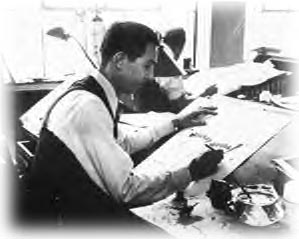Model animation usually consists of creating 3D models usually from plastercine, paper or plastic objects. In order to use this un-movable objects to create a moving picture you first must bring the objects to life, how else than by using stop motion.
Stop motion with model based animation works by placing the object in the desired area/scene and photographing it before moving it slightly by hand to photograph again. By doing this a number of time you will eventually mimic the illusion of movement. When playing the animation back the human mind perceives the photographs of slightly changed objects to actually appear that the object is alive and moving on its own.
Model based stop motion animation
amateur model animation
One of the most famous model animators known is a man called Art Clokey. In the 1930-1950's animation was becoming increasingly popular with walt disney creating full length animated films with competitors the fleicher brothers doing similar projects. Clokey decided to make his animation from plastercine. In 1955-1982 he created a character called Gumby.
Art Clokey first animation gumbasia
Gumby
Plastercine isn't the only substance that can be used to make 3D models another popular material is wood. using wooden characters as models for animation has been very popular with students and amateur film makers using these characters is believed to be easier and more realistic as it represents a human and can move with the same joints like real people do.
example of wooden animation
Although model animation is effective and gives excellent results when used properly we have adapted to that style of animation and now create amazing styles of coloured cartoon animations such as Walt Disney films. This is called cell based animation.
WHAT IS CELL BASED ANIMATION?
"A traditional form of animation used in the production of cartoons or animated movies where each frame of the scene is dran by hand. A full-length feature film produced using cel animation would often require a million or more drawings to complete" - http://www.webopedia.com/TERM/C/cel_animation.html
Cell based animation because very popular 1930's and was most famously seen with the Walt Disney film Snow white. Windsor McCkay demonstrated the same style on cell based animation but this was before plastic was created so his animation was shown on paper. The process of using cell based animation is firstly a story board is made by all the animator and directors coming together to discus the entire film. Once they are made the storyboards are presented as the story, after it has been laid out the dialogue is recorded. This tends to be done before animation that that the animators know exactly what the characters will say. Once the dialogue is recorded the animator make rough sketches of the characters they are usually rather messy with no colour or background. Once the entire film has been drawn out on paper they are transported to the inking department where the inkers copy the animation drawings on clear celluloid acetate these days known as plastic. After the inking department have outlines the characters the unfinished cells go into the painting department where the painters flip the cel over and paint all the colours needed to created the characters characteristics on the back, they do this so that the character appears crisp with an outline.Before the cels get photographed a background image must be added, as the cel is clear with only a character on once a background is created it can be placed directly underneath the character. Usually the backgrounds are painted with water colour paint, in some Disney productions the backgrounds were painted on glass with glass painted backgrounds to create the illusion of extreme movement. With all the combined elements the images can now be photographed. Although the final product is not filmed with a normal projector or camera, but with a lens mounted facing down onto a table top which is covered with the cels that have been created. they cover them in a large piece of glass and then the images are photographes. Once the drawings are filmed the dialogue is added and occasionally the film is edited at this step the animation is now complete.
artist drawing characters to be animated

short film that was created using cel animation
If that isn't enough explanation a well known example to demonstrate how cell based animation is created is stick men drawings drawn in a flip book. Many people do this during childhood and it is perfect to demonstrate just how cel based animation works.
During class i decided to create my own animation using plastercine i played around with different models for a while and then decided to create an apple falling from a tree. enjoy.







